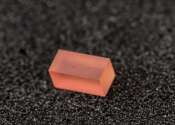New state of water molecule discovered
Neutron scattering and computational modeling have revealed unique and unexpected behavior of water molecules under extreme confinement that is unmatched by any known gas, liquid or solid states.

Neutron scattering and computational modeling have revealed unique and unexpected behavior of water molecules under extreme confinement that is unmatched by any known gas, liquid or solid states.
Condensed Matter
Apr 22, 2016
17
13261

In the popular movie franchise "Back to the Future", an eccentric scientist creates a time machine that runs on a flux capacitor.
Quantum Physics
May 28, 2018
12
4013

An international team of scientists studying ultrafast physics have solved a mystery of quantum mechanics, and found that quantum tunneling is an instantaneous process.
Quantum Physics
May 27, 2015
32
1230

Iron screws and other so-called ferromagnetic materials are made up of atoms with electrons that act like little magnets. Normally, the orientations of the magnets are aligned within one region of the material but are not ...
Condensed Matter
Mar 28, 2024
0
929

(Phys.org)—Scientists have discovered an anomaly in the properties of ice at very cold temperatures near 20 K, which they believe can be explained by the quantum tunneling of multiple protons simultaneously. The finding ...

In a remarkable feat of micro-engineering, UNSW physicists have created a working transistor consisting of a single atom placed precisely in a silicon crystal.
Nanophysics
Feb 19, 2012
24
2

A team of researchers at the University of Illinois has demonstrated that, counter to classical Newtonian mechanics, an entire collection of superconducting electrons in an ultrathin superconducting wire is able to "tunnel" ...
Nanophysics
May 27, 2009
6
0

Quantum biology is an emerging field of science, established in the 1920s, which looks at whether the subatomic world of quantum mechanics plays a role in living cells. Quantum mechanics is an interdisciplinary field by nature, ...
General Physics
Feb 22, 2021
4
6261

Once unimaginable, transistors consisting only of several-atom clusters or even single atoms promise to become the building blocks of a new generation of computers with unparalleled memory and processing power. But to realize ...
General Physics
May 11, 2020
0
3312

(Phys.org)—As long as the temperature is above absolute zero, gas molecules are always in constant random motion. They may diffuse—or spread out—through three-dimensional space or, in a process called "surface diffusion," ...
Wave-mechanical tunnelling (also called quantum-mechanical tunnelling, quantum tunnelling, and the tunnel effect) is an evanescent wave coupling effect that occurs in the context of quantum mechanics because the behaviour of particles is governed by Schrödinger's wave-equation. All wave equations exhibit evanescent wave coupling effects if the conditions are right. Wave coupling effects mathematically equivalent to those called "tunnelling" in quantum mechanics can occur with Maxwell's wave-equation (both with light and with microwaves), and with the common non-dispersive wave-equation often applied (for example) to waves on strings and to acoustics.
For these effects to occur there must be a situation where a thin region of "medium type 2" is sandwiched between two regions of "medium type 1", and the properties of these media have to be such that the wave equation has "traveling-wave" solutions in medium type 1, but "real exponential solutions" (rising and falling) in medium type 2. In optics, medium type 1 might be glass, medium type 2 might be vacuum. In quantum mechanics, in connection with motion of a particle, medium type 1 is a region of space where the particle total energy is greater than its potential energy, medium type 2 is a region of space (known as the "barrier") where the particle total energy is less than its potential energy - for further explanation see the section on "Schrödinger equation - tunnelling basics" below.
If conditions are right, amplitude from a traveling wave, incident on medium type 2 from medium type 1, can "leak through" medium type 2 and emerge as a traveling wave in the second region of medium type 1 on the far side. If the second region of medium type 1 is not present, then the traveling wave incident on medium type 2 is totally reflected, although it does penetrate into medium type 2 to some extent. Depending on the wave equation being used, the leaked amplitude is interpreted physically as traveling energy or as a traveling particle, and, numerically, the ratio of the square of the leaked amplitude to the square of the incident amplitude gives the proportion of incident energy transmitted out the far side, or (in the case of the Schrödinger equation) the probability that the particle "tunnels" through the barrier.
This text uses material from Wikipedia, licensed under CC BY-SA